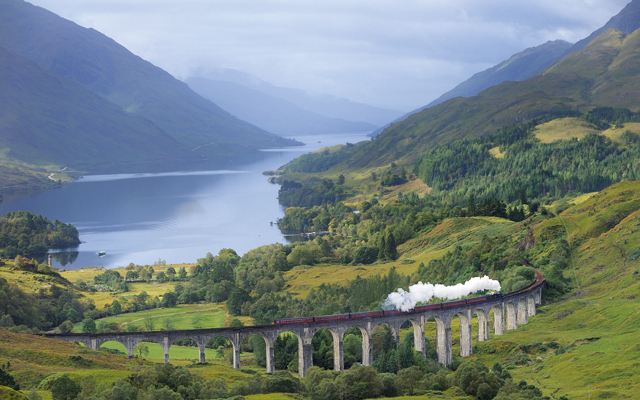Bridging the gap: great British bridges through history
Practical, ingenious, sometimes beautiful and often romantic, bridges have simply transformed the way we get from A to B.


Testwood Lakes Bridge, Hampshire, about 1,500bc In 1998, archaeologists uncovered two parallel rows of timbers, the remains of the oldest known bridge in Britain, at Testwood Lakes in Hampshire. The bridge extended to 72ft and has been carbon dated to 1,500bc.
Tarr Steps, Exmoor, about 1,000bc At 60 yards, the longest clapper (from the medieval Latin claperius, or pile of stones) bridge in the British Isles, it consists of giant slabs and is believed to be 3,000 years old.
Willowford Bridge, Hadrian’s Wall, about 122 Those Romans knew a thing or two about bridge building, being the first to understand the potential of arches, deploy concrete and work out how to use cofferdams to build foundations under water. No intact Roman bridges survive in the UK—probably because most of them were of wood rather than stone but the foundations of an excellent example, with sluices, can be seen at Willowford.
London Bridge, about 1179 After the Romans left in ad410, their bridges slowly fell into disrepair and fords re-emerged as the most common way to cross rivers. Between the 10th and 12th centuries, however, a golden age of bridge building occurred, especially after William the Conqueror came to power. London Bridge had been built and rebuilt in timber until 1179, when the first stone bridge was completed, according to Alan Cooper, ‘on the initiative of the king, who drew from the knowledge he had gainedin his French possessions, using a French builder who employed French building techniques and introducing a French method of financing’. Take that, UKIP!
Packhorse Bridge, West Rasen, Lincolnshire, about 14th century This tiny gem of a bridge is typical of those built for foot passengers and packhorses during the Middle Ages.
Rotherham Bridge, Rotherham, 1483 Hundreds of medieval bridges are still in use throughout the country, many of which originally incorporated chapels (to collect money to maintain the bridge), including this wonderful example in Rotherham.
High Bridge, Lincoln, about 1540 The financers of medieval bridges (generally, religious orders, local landowners or town guilds) frequently defrayed their costs by incorporating houses and shops into the structure. Lincoln High Bridge is the last remaining example. Prior to the Reformation, it was possible to gain indulgences by funding the building and repairing of bridges. Until well after the Middle Ages,it was considered an act of charity to finance bridge work.
Sign up for the Country Life Newsletter
Exquisite houses, the beauty of Nature, and how to get the most from your life, straight to your inbox.
Sturminster Newton Bridge, Dorset, 16th century onwards As traffic increased and the use of carts and then carriages became more common, many medieval bridges were widened. At Sturminster Newton, the arches between the cutwaters were extended to provide an additional 6ft of room.
Clare Bridge, Cambridge, about 1640 Most British bridge builders allowed the Renaissance to pass them by, but there were a few exceptions, including the arched bridge at Blenheim (1708), the Palladian-style bridge at Stowe (1738) and the ornamental bridge at Chatsworth (1759). The first and best example of the bridge as a conscious work of art, however, was the classically styled Clare Bridge in Cambridge (1640).
Sonning Bridge, Berkshire, 1775 One can only imagine how European bridge designers must have looked down their Con- tinental noses at their British counterparts, who largely eschewed both structural improvements and more elegant designs. For evidence, look no further than Sonning Bridge in Berkshire. It was constructed from brick rather than stone, but, otherwise, it could have been built in 1273, not 1775.
Ironbridge, Shropshire, 1777–81 Thanks to Abraham Darby (and the sequels, Abraham Darby II and III), the cost of produc- ing iron fell dramatically over the course of the 18th century making it possible, in 1779, to create the first iron arch bridge in the world. British bridge designers could, once again, hold their heads up high.
District Line Bridge, Cromwell Road, London, about 1865 Innovation upon innovation, first iron and then concrete. In the 18th and 19th centuries, where British bridge builders led, the rest of the world followed. It all began with a concrete bridge designed by Thomas Marr Johnson for the District Line, near Cromwell Road, London, in about 1865.
Glenfinnan Viaduct, Scotland, 1901 Reinforced concrete increasingly became the material of choice for British bridge builders from the mid 19th century to the mid 20th century. The Glenfinnan Viaduct, Loch Sheil famous for its appearance in the ‘Harry Potter’ films is an unusually attractive example of the type (one viewer enthusiastically described it as ‘a poetic essay in mass concrete’). Sadly, however, the majority of builders opted for practicality (and pebbledash) over beauty.
Bailey Bridge, Ford Green, Medway, about 1946 Developed by Donald Bailey, a British civil servant who loved making models, during the Second World War, Bailey bridges were transportable and quick to assemble using only common hand tools. Gen Montgomery remarked that, without them, the Allies wouldn’t have won the war (a useful point to make to any American who suggests otherwise).
Redeployed after 1945, examples can still be found in unexpected places throughout the country. I’ve come across what I believe to be originals (beware of imitations) near Ford Green on the Medway and also north of Newport Pagnell on the Great Ouse. If you’re a serious bridge anorak, you probably already know that there’s a prototype at Stanpit Marsh, Dorset.
Severn Bridge, Avon, 1966 Leaving aside early examples made from ropes, and ignoring eight made from metal and wire in Bhutan in 1433 (the last was in use until 2004), we British were really the first (in the early 1800s) to seriously develop the concept of the suspension bridge. There are dozens of examples, but, for me, the simple, pure lines of the Severn Bridge, finished in 1966, are the most beautiful.

From opening to enjoying: A guide to champagne appreciation [VIDEO]
A lesson in champagne.
Country Life is unlike any other magazine: the only glossy weekly on the newsstand and the only magazine that has been guest-edited by HRH The King not once, but twice. It is a celebration of modern rural life and all its diverse joys and pleasures — that was first published in Queen Victoria's Diamond Jubilee year. Our eclectic mixture of witty and informative content — from the most up-to-date property news and commentary and a coveted glimpse inside some of the UK's best houses and gardens, to gardening, the arts and interior design, written by experts in their field — still cannot be found in print or online, anywhere else.
-
 Vertigo at Victoria Falls, a sunset surrounded by lions and swimming in the Nile: A journey from Cape Town to Cairo
Vertigo at Victoria Falls, a sunset surrounded by lions and swimming in the Nile: A journey from Cape Town to CairoWhy do we travel and who inspires us to do so? Chris Wallace went in search of answers on his own epic journey the length of Africa.
By Christopher Wallace
-
 A gorgeous Scottish cottage with contemporary interiors on the bonny banks of the River Tay
A gorgeous Scottish cottage with contemporary interiors on the bonny banks of the River TayCarnliath on the edge of Strathtay is a delightful family home set in sensational scenery.
By James Fisher